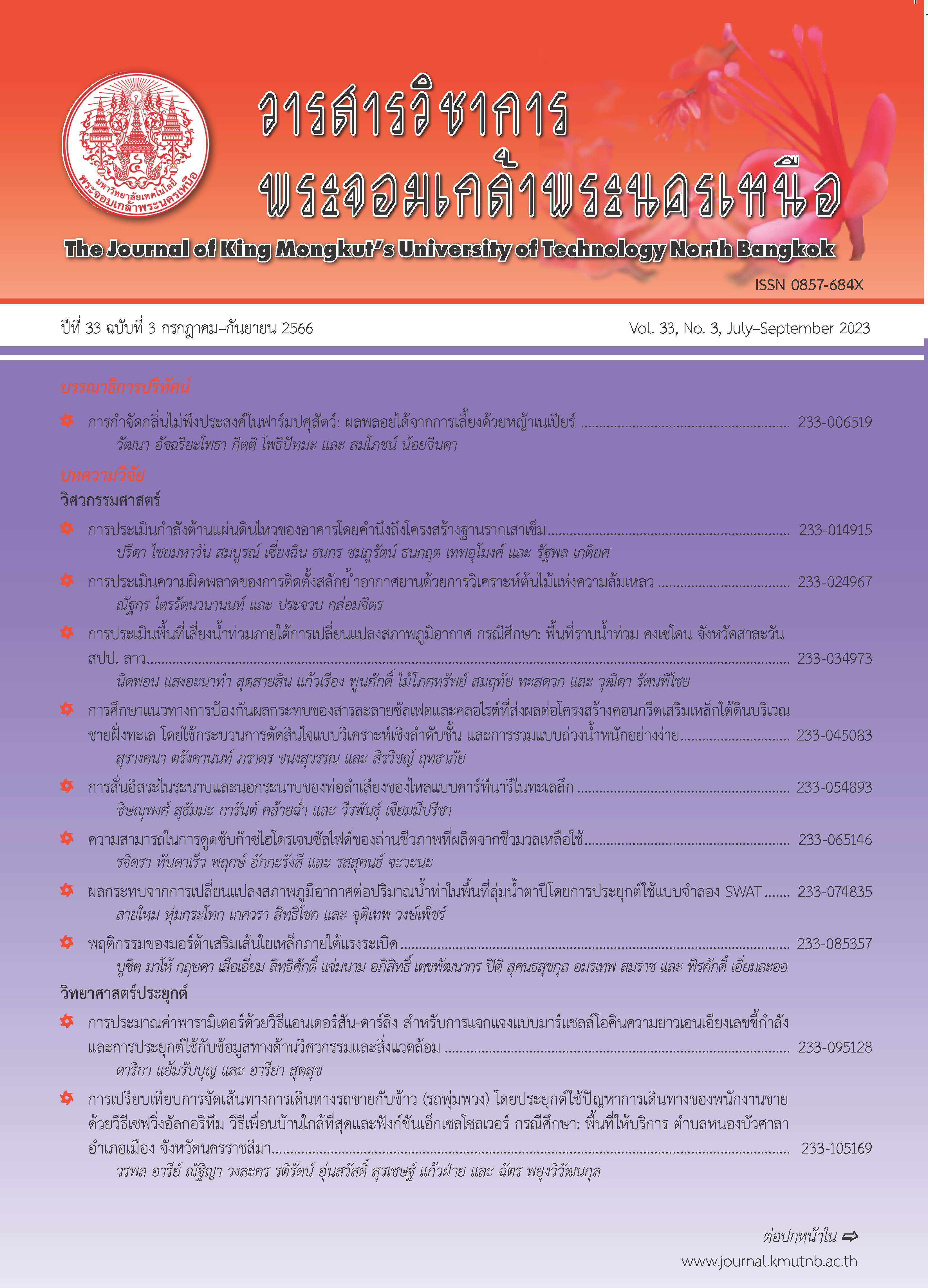การประเมินพื้นที่เสี่ยงน้ำท่วมภายใต้การเปลี่ยนแปลงสภาพภูมิอากาศ กรณีศึกษา: พื้นที่ราบน้ำท่วม คงเซโดน จังหวัดสาละวัน สปป. ลาว
Main Article Content
บทคัดย่อ
การวิจัยนี้มีวัตถุประสงค์เพื่อประเมินพื้นที่เสี่ยงน้ำท่วมอันเนื่องจากการเปลี่ยนแปลงสภาพภูมิอากาศ ในพื้นที่ราบน้ำท่วมถึงคงเซโดน จังหวัดสาละวัน สปป. ลาว โดยแบ่งวิธีการศึกษาออกเป็น 5 ส่วนย่อย ได้แก่ 1) การสกัดและการปรับแก้ข้อมูลภูมิอากาศในช่วง ค.ศ. 2020–2100 จากแบบจำลอง Mixed Resolution version of Max Planck Institute Earth System Model (MPI-ESM-MR) ภายใต้การปล่อยก๊าซเรือนกระจกในระดับปานกลาง (RCP4.5) และระดับสูงมาก (RCP8.5) ข้อมูลภูมิอากาศได้ถูกสกัดและปรับแก้ความถูกต้องด้วยแบบจำลอง CMhyd 2) การประเมินปริมาณน้ำท่าในอนาคตภายใต้เงื่อนไข RCP4.5 และ RCP8.5 โดยใช้แบบจำลอง SWAT 3) การวิเคราะห์ขนาดและความถี่ของน้ำท่วมโดยใช้การแจกแจง Log Pearson Type III จากปริมาณน้ำท่าสูงสุดรายปีจากแบบจำลอง SWAT และจากการตรวจวัดในอดีตในช่วง ค.ศ. 1993–2019 ซึ่งปริมาณน้ำท่วมสูงสุดที่คาดว่าจะเกิดขึ้นในอนาคตได้กำหนดรอบปีการเกิดซ้ำที่แตกต่างกัน ได้แก่ รอบ 25, 50, 100 และ 200 ปี 4) การจำลองลักษณะทางชลศาสตร์ เพื่อหาความลึกของน้ำท่วมและความเร็วน้ำท่วม ของแต่ละรอบปีการเกิดซ้ำโดยใช้ แบบจำลอง HEC-RAS และ 5) การประเมินระดับพื้นที่เสี่ยงน้ำท่วม โดยใช้หลักการ Flood Hazard Rating (FHR) ด้วยโปรแกรม ArcGIS ผลการศึกษาชี้ให้เห็นว่าพื้นที่เสี่ยงน้ำท่วมเนื่องจากการเปลี่ยนแปลงสภาพภูมิอากาศภายใต้เงื่อนไข RCP4.5 และ RCP8.5 มีแนวโน้มที่จะเพิ่มขึ้น และพื้นที่เสี่ยงน้ำท่วมภายใต้เงื่อนไข RCP8.5 จะสูงกว่า RCP4.5 โดยเฉลี่ยประมาณ 7.44% ค่าความแตกต่างนี้ชี้ให้เห็นว่าการจัดการความเสี่ยงจากน้ำท่วมภายใต้เงื่อนไข RCP8.5 ควรเพิ่มระดับการจัดการมากกว่า RCP4.5 พื้นที่เสี่ยงน้ำท่วมระดับมาก ส่วนใหญ่อยู่บริเวณด้านต้นน้ำและท้ายน้ำ และพื้นที่เสี่ยงปานกลางส่วนใหญ่อยู่บริเวณตอนกลางทั้งในเงื่อนไข RCP4.5 และ RCP8.5 ส่วนปริมาณฝนในช่วงฤดูแล้งเพิ่มขึ้น 9.27% (RCP4.5) และ 1.27% (RCP8.5) และช่วงฤดูฝนเพิ่มขึ้น 17.42% (RCP4.5) และ 21.98% (RCP8.5) สำหรับปริมาณน้ำท่าในช่วงฤดูแล้งเพิ่มขึ้น 8.16% (RCP4.5) และ 4.07% (RCP8.5) ส่วนในฤดูฝนเพิ่มขึ้น 13.43% (RCP4.5) และ 18.11% (RCP8.5) ผลที่ได้รับจากการวิจัยครั้งนี้มีประโยชน์อย่างยิ่งในการให้ข้อมูลเบื้องต้นแก่หน่วยงานที่เกี่ยวข้องและคนในชุมชนเพื่อเตรียมรับมือกับเหตุการณ์อุทกภัยโดยเฉพาะการจัดการการใช้ที่ดิน
Article Details

อนุญาตภายใต้เงื่อนไข Creative Commons Attribution-NonCommercial-NoDerivatives 4.0 International License.
บทความที่ลงตีพิมพ์เป็นข้อคิดเห็นของผู้เขียนเท่านั้น
ผู้เขียนจะต้องเป็นผู้รับผิดชอบต่อผลทางกฎหมายใดๆ ที่อาจเกิดขึ้นจากบทความนั้น
เอกสารอ้างอิง
Ministry of Natural Resources and Environment, “Climate change in Laos yearly 2015,” MNRE, Vientiane, Laos, Mar. 2015.
Division of Labour and Social Welfare, “Effects of flood in Khongsedon district, Salavan province in years 2019,” DLSW, Vientiane, Laos, Dec. 2019.
B. Ntanganedzeni and J. Nobert, “Flood risk assessment in Luvuvhu river, Limpopo province, South Africa,” Physics and Chemistry of the Earth, Parts A/B/C, pp. 102959, 2020.
B. Simphaly, “Application of geographic information system for establishing flood map in the Xedon river basin,” M.S. thesis, Department of Water Resources Management and Development, Faculty of Water Resources National University of Laos, 2019.
S. Thoummalangsy, “Flood risk assessment for suitable land use management in Xebangfai floodplain, Khammouane province, Lao PDR,” M.S. thesis, Sustainable Land Use and Natural Resource Management Program, Graduate School, Kasetsart University, 2019 (in Thai).
M. Parry, M. L. Parry, O. Canziani, J. Palutikof, P. Van der Linden, and C. Hanson, Climate change 2007-impacts, adaptation and vulnerability: Working group II contribution to the fourth assessment report of the IPCC. New York: Cambridge University Press, 2007.
A. Watts, G. Grant, and M. Safeeq. (2016, July). Flows of the future—How will climate change affect streamflows in the Pacific Northwest?. United States Department of Agriculture. Portland, USA. [Online]. Available: https:// www.fs.fed.us/pnw/sciencef/scifi187.pdf.
X. D. Huang, L. Wang, P. P. Han, and W. C. Wang, “Spatial and temporal patterns in nonstationary flood frequency across a forest watershed: Linkage with rainfall and land use types,” Forests, vol. 9, no. 6, pp. 339–359, 2018.
M. S. Iqbal, Z. H. Dahri, E. P. Querner, A. Khan, and N. Hofstra, “Impact of climate change on flood frequency and intensity in the Kabul River Basin,” Geosciences, vol. 8, no. 4, pp. 114–129, 2018.
N. Nyaupane, B. Thakur, A. Kalra, and S. Ahmad, “Evaluating future flood scenarios using CMIP5 climate projections,” Water, vol. 10, no. 12, pp. 1866–1883, 2018.
J. I. Barredo, G. Caudullo, and A. Mauri, “Mediterranean habitat loss under RCP4. 5 and RCP8. 5 climate change projections,” European Commission’s science and knowledge service, Luxembourg, 2017.
R. H. Moss, J. A. Edmonds, K. A. Hibbard, M. R. Manning, S. K. Rose, D. P. Van Vuuren, and T. J. Wilbanks, “The next generation of scenarios for climate change research and assessment,” Nature, vol. 463, no. 7282, pp. 747–756, 2010.
CMhyd user manual, Texas Agricultural Experiment Station and USDA Agricultural Research Service, Washington, D.C, USA, 2016.
B. Zhang, N. K. Shrestha, P. Daggupati, R. Rudra, R. Shukla, B. Kaur, and J. Hou, “Quantifying the impacts of climate change on streamflow dynamics of two major rivers of the Northern Lake Erie Basin in Canada,” Sustainability, vol. 10, no. 8, pp. 2897–2919, 2018.
SWAT Calibration and Uncertainty Programs Manual Version 2, SWAT-CUP2, 2011.
SWAT Calibration and Uncertainty Programs, SWAT-CUP, 2008.
V. Kasioudom, Hydrology, Vientiane: Faculty of Water Resources, National University of Laos, 2009.
K. Fletcher, SENTINEL 1: ESA's Radar Observatory Mission for GMES Operational Services, Paris: European Space Agency, 2012.
P. A. Brivio, R. Colombo, M. Maggi, and R. Tomasoni, “Integration of remote sensing data and GIS for accurate mapping of flooded areas,” International Journal of Remote Sensing, vol. 23, no. 3, pp. 429–441, 2002.
S. Martinis, A. Twele, and S. Voigt, “Towards operational near real-time flood detection using a split-based automatic thresholding procedure on high resolution TerraSAR-X data,” Natural Hazards and Earth System Sciences, vol. 9, no. 2, pp. 303–314, 2009.
H.R. Wallingford, “Flooding in boscastle and north cornwall, August 2004. Phase 2 Studies Report,” HR Wallingford Limited, Wallingford, UK, Rep. EX5160, 2005.
S. J. Priest, S. M. Tapsell, E. C. Penning-Rowsell, C. Viavattene, and T. Wilson. (2008, June 15). Building models to estimate loss of life for flood events: executive summary. [Online]. Available: http://www.floodsite.netFlood.
R. K. Pachauri and L. A. Meyer, “Climate change 2014: synthesis report. Contribution of Working Groups I, II and III to the fifth assessment report of the Intergovernmental Panel on Climate Change,” IPCC, Geneva, Switzerland, 2014.

